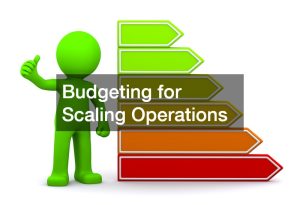Introduction
Effective growth and expansion are direct results of meticulous planning and budgeting. When business owners aim for expansion, understanding the nuances of financial preparedness becomes critical to avoid potential pitfalls. A sustainably growing business needs a solid financial backbone to support its expansion endeavors, ensuring that both long-term and short-term goals are met efficiently.
Business owners must prioritize financial preparedness to avoid jeopardizing their business during expansion. Budgeting effectively allows them to allocate resources to essential areas, from marketing to infrastructure development. Through strategic financial planning, entrepreneurs can maintain a balance between growth aspirations and financial stability, leading to successful expansion.
Without proper budgeting, even the most ambitious growth strategies can falter. Business owners need to anticipate costs associated with growth and ensure there is a robust financial structure to support these expenses. By doing so, they can secure their business’s future and pave the way for sustained growth.
1. Setting the Foundation for Growth with Strategic Budgeting

Defining clear business goals is the first step in successful strategic budgeting. Business owners should set both short-term and long-term objectives that align with their growth ambitions. Creating specific, measurable goals helps guide the budgeting process, ensuring that funds are earmarked for crucial activities such as hiring new employees, upgrading technology, or expanding into new markets.
Conducting a thorough market and cost analysis is essential to understanding the financial landscape. Using market research tools and consulting with industry experts can provide a detailed forecast of potential costs associated with expansion. Allocating funds for market research, competitive analysis, and industry consultants ensures the business is well-prepared for growth-related expenses.
Strategic budgeting also involves anticipating various expansion scenarios. Business owners must factor in both fixed and variable costs in their budgeting templates. By preparing for different outcomes, they can ensure a smooth growth trajectory and mitigate risks associated with unplanned financial disruptions.
2. Building an Expansion Budget
Establishing a comprehensive growth budget is crucial for managing business expansion. This budget should break down key elements such as marketing, operations, staffing, and infrastructure. Creating a detailed budget template that accommodates both fixed and variable costs allows business owners to allocate resources more effectively, ensuring that all critical areas are covered during the expansion phase.
Allocating funds to high-priority investments can significantly impact the success of a business’s growth and expansion efforts. Key areas such as digital infrastructure, employee training, and new equipment should be given precedence. By prioritizing spending on initiatives that have an immediate and substantial impact on growth, such as marketing and customer acquisition, businesses can optimize their growth strategies.
When building an expansion budget, emphasizing scalability is paramount. Business owners should focus on creating a financial plan that supports scalable operations. This includes addressing both current needs and future growth opportunities, ensuring that the business can handle increased demand without compromising quality or operational efficiency.
3. Exploring Financing Options for Expansion
Securing adequate funding is often necessary to support extensive growth and expansion plans. Business owners can explore various funding options, including traditional loans, angel investors, and government grants specifically available to small businesses in the USA. Utilizing resources such as SBA loans or crowdfunding can provide the necessary capital to fuel expansion without putting undue strain on the business’s financial health.
Leveraging existing cash flow is another effective strategy for supporting business growth. By reinvesting a portion of profits into high-impact growth areas such as marketing and product development, businesses can achieve expansion without taking on excessive debt. This approach ensures that the business remains financially stable while still pursuing its growth objectives.
Exploring diverse financing options allows businesses to choose the most suitable method for their specific needs. Whether opting for debt financing, equity financing, or internal cash flow, each option has its own set of advantages and potential drawbacks. Business owners must evaluate these factors carefully to make informed decisions that align with their growth strategies.
4. Budgeting for Scaling Operations

Controlling operational costs becomes increasingly important as a business scales its operations. Strategies such as outsourcing non-core functions, implementing automation, and adopting lean management practices can help reduce operational expenses. By focusing on efficiency and cost control, businesses can maintain profitability even during periods of rapid growth.
Financial forecasting is a critical component of budgeting for future growth. Business owners should develop detailed financial forecasts that account for various growth scenarios, such as conservative, moderate, and aggressive expansion. Utilizing financial forecasting software can help simulate these scenarios, enabling businesses to adjust their budgets accordingly and prepare for different outcomes.
Effective cost management and accurate forecasting are essential for sustaining growth. When operational costs are controlled and future financial needs are anticipated, businesses can navigate their expansion journey with greater confidence. This proactive approach minimizes risks and ensures that the business remains on a stable financial footing throughout its growth trajectory.
5. Marketing on a Budget
Implementing budget-friendly marketing strategies is crucial for businesses aiming to maximize their growth and expansion without overspending. Cost-effective methods such as digital marketing, social media advertising, and email campaigns can deliver high returns on investment. By focusing on strategies that offer significant impact at a lower cost, businesses can achieve their marketing goals more efficiently.
Building brand awareness doesn’t necessarily require a large marketing budget. Leveraging public relations, forming strategic partnerships, and encouraging customer referrals are excellent ways to enhance visibility without incurring significant expenses. Utilizing free tools, such as Google My Business, and creating referral programs can further amplify a business’s reach and reputation.
Allocating budget to low-cost, high-impact marketing efforts should be a priority for business owners. Content marketing and search engine optimization (SEO) are effective methods to attract and engage customers continually. By investing in these areas, businesses can build a strong online presence and drive sustainable growth while keeping marketing expenses in check.
6. Planning for Unexpected Costs
Planning for unexpected costs is a crucial aspect of budgeting for growth and expansion. Business owners should allocate a portion of their budget to create a contingency fund – typically around 10-20% of the total budget. This fund serves as a financial safety net, allowing the business to address unforeseen challenges such as equipment failures, legal fees, or sudden marketing shifts without disrupting operational stability.
Effective risk management involves identifying potential risks that could impact the business’s expansion plans. Factors such as economic downturns, supply chain disruptions, and regulatory changes should be considered. By addressing these potential risks and incorporating them into the budgeting process, businesses can develop more robust and resilient growth strategies.
Maintaining a healthy financial cushion is essential for navigating unforeseen circumstances. Businesses should ensure they have adequate cash reserves to cover unexpected expenses. This financial buffer provides the stability needed to tackle challenges head-on and sustain growth even when unexpected costs arise.
7. Optimizing the Budget During Growth
Regularly tracking financial performance is essential for optimizing the budget during periods of growth. Business owners should review their budgets quarterly and make necessary adjustments based on real-time data, sales performance, and market trends. This ongoing evaluation process ensures that the budget remains aligned with the business’s growth objectives and financial health.
Identifying areas for cost reduction without sacrificing quality is a key aspect of budget optimization. Business owners can negotiate better terms with suppliers, find cost-effective alternatives, and streamline processes to save money. These measures allow businesses to reduce expenses and maintain profitability while still delivering high-quality products or services to their customers.
Optimizing the budget during growth requires a proactive and dynamic approach. By continuously monitoring financial performance and making informed adjustments, businesses can ensure their budget supports sustainable growth. This adaptability is crucial for navigating the evolving business landscape and achieving long-term success.
8. Case Studies: Budgeting for Successful Expansion
Case Study 1: A Small Retail Business Expands Nationally on a Tight Budget. An example of a retail business that achieved national expansion through strategic budgeting and financing. By prioritizing high-ROI marketing efforts and operational efficiency, the business successfully navigated growth challenges and expanded to multiple states without significant financial strain.
Case Study 2: A Service-Based Business Leverages Budgeting for Digital Expansion. In this case, a service-based business managed its growth by reallocating its budget towards digital marketing and online tools. The business optimized its lean budget to focus on effective marketing strategies and automation, leading to successful digital expansion and increased market presence.
Both case studies highlight the importance of strategic budgeting and financial planning in successful business expansion. By prioritizing high-impact investments and maintaining operational efficiency, these businesses achieved sustainable growth while effectively managing their financial resources.
Conclusion
In conclusion, effective budgeting is a cornerstone of successful business growth and expansion. By setting clear goals, conducting thorough market and cost analysis, and establishing a comprehensive growth budget, business owners can ensure they are well-prepared for expansion challenges. Securing funding, controlling operational costs, and exploring budget-friendly marketing strategies further contribute to achieving sustainable growth.
Financial preparedness and adaptability are crucial for navigating the dynamic landscape of business expansion. Business owners should regularly track their financial performance, adjust budgets as needed, and plan for unexpected costs. By doing so, they can maintain financial stability and continue to pursue their growth objectives with confidence.
Business owners are encouraged to implement the strategies discussed in this article and explore related resources to support their growth and expansion efforts. For more information, check out “How to Grow My Business Online”. By prioritizing financial planning and strategic budgeting, businesses can achieve long-term success and growth.

